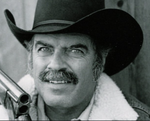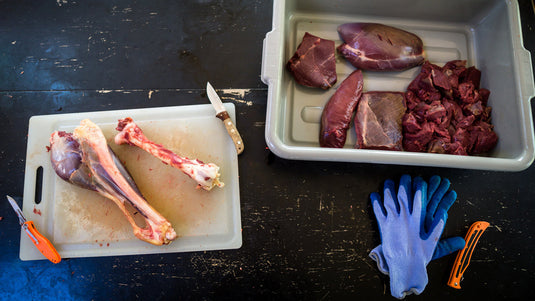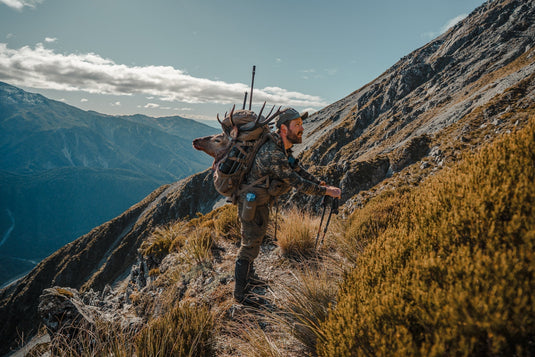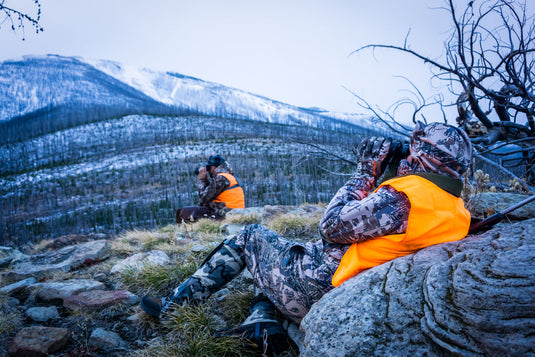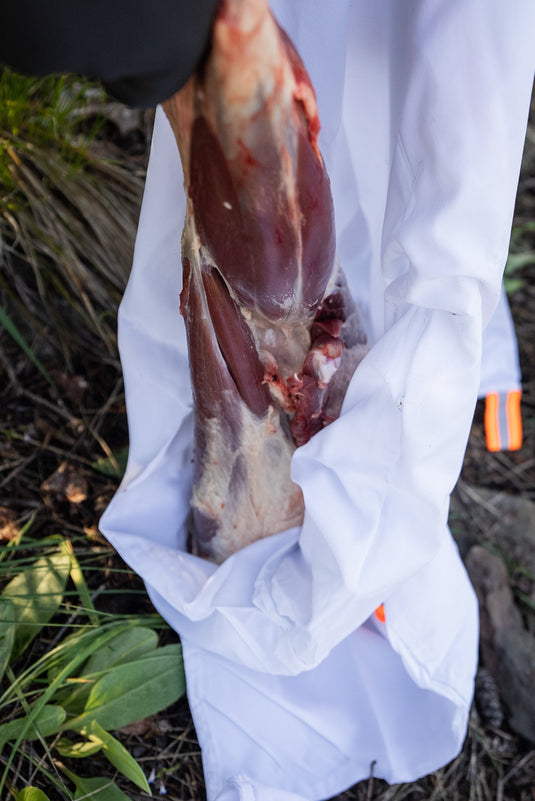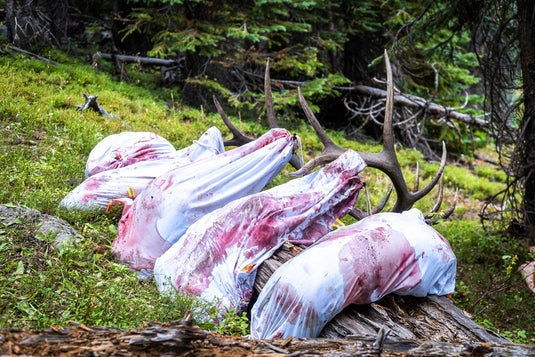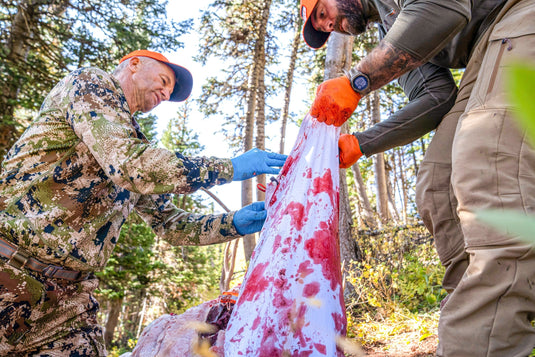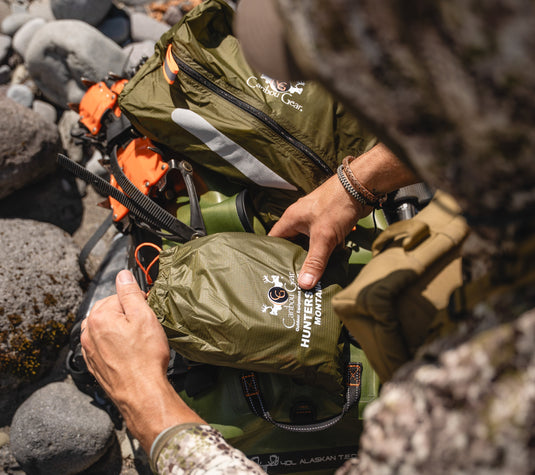Elk hunters who venture out west for the first time often make mistakes that will almost guarantee an unfilled tag. Having said that, even hunters who have pursued elk also make mistakes. Here’s what many experienced hunters consider the top 5 mistakes made by elk hunters.

Now that I’m in my golden years I understand their dilemma. The answer to getting in shape is first visiting your doctor and then proceeding with his/her advice. Obviously, if you have heart issues you might not want to climb up and down stairs to strengthen your knees or legs or any other exercises that might be harmful. Always keep your shortcomings in mind and act accordingly when you’re in elk country. Your hunting buddies should also be aware of any limitations. For example, something as simple as splitting firewood might be an easy chore for someone in good shape, but painful and dangerous for a person who has a bad back, knees, or respiratory or heart issues. It’s always better to be safe than sorry.
2. TO BUGLE OR NOT TO BUGLE. Of all the big game animals in the US that vocalize, elk are the grand champions. Other critters vocalize as well, such as deer, moose, coyotes and others, but in my opinion it’s the elk that offers the most chilling, thrilling call of all, whether it’s a bugle made by a bull, or a mew made by a cow or calf. Basic understanding of vocalizing during the rut is essential. For starters, the peak of the elk rut varies from region to region, but it’s safe to say the main window is from mid-September to mid-October. That doesn’t mean elk aren’t in breeding mode in early September. It’s very possible to hear bugling activity at that time. You might often hear elk bugle after mid-October, but that’s usually because a cow wasn’t bred the first time she came in heat and came into estrus later on.
Common mistakes are not understanding why the bull is bugling. You should learn that answer the first time you respond to the bull. His reaction to your call should give you some insight as to why he’s bugling. Did he respond immediately to your call? Did it sound like he moved closer? Did he remain silent?

You should also be aware of the basic techniques of using the cow call. Of course, there’s an interesting learning curve when attempting to analyze why elk vocalize. The best way to learn, of course, is by observing firsthand, but if it’s your first visit to the elk woods you can Google dozens of videos and read books and magazines on the subject. Nothing can take the place of educating yourself in the woods, but you need to start the learning process somewhere.
One of the biggest mistakes you can make is calling from a location where human traffic is heavy. For example, say you’re driving your pickup or ATV down a forest road on public land. It’s prime time for the rut and you stop at a pullout, get out of your vehicle and make a call into a beautiful timbered draw that promises elk. Nothing answers. You drive down the road to another pullout. The same thing happens. These failures lead you to believe there are no elk in the area or they aren’t interested in responding. Chances are good that the places you called from were also called by many other hunters. Elk are wary. They know the road is there, they hear the vehicles and maintain a lockjaw attitude. Resolve the problem by parking your rig, grabbing your gun and backpack and head as deep in the timber as you can. Do not call as you go until you’re in a place where you see fresh elk sign. Very often if you call in a bull’s backyard, he’ll come unglued and come charging when you bugle. It’s happened to me many times.
3. MISSING THE GOLDEN MINUTES. Elk are diurnal which means they feed early in the morning, all night, and late in the afternoon. Not being in the woods during these periods can mean eating your tag. Of course, it’s not legal to hunt at night. In most states legal shooting hours are a half hour before sunup to a half hour after sundown. This requires you to get out of the comfy sleeping bag long before sunrise and get out of camp with enough time to be positioned at the place you intend to watch the morning being born. I like to hike to a high location where I have good visibility, hoping to see elk feeding in meadows below.

If you’re too late you may miss them altogether since they’re headed to bedding areas for the rest of the day. If you spot a herd, you can make a plan to try to hunt them in the timber where they were headed or leave them alone and set up an ambush near the area where they entered the timber. As the shadows grow long, they’ll typically return to the meadow where you saw them in the morning.
Hunting elk late in the afternoon is a great strategy. Unfortunately, many hunters aren’t willing to watch a meadow until the last minute of shooting light. That means a walk out of the woods in the dark — and if an elk is killed in the last few minutes, that means it must be field dressed in the dark, skinned and cut in pieces. Unless the hunters have horses or an ATV nearby where they can load the elk, they’ll have to return for it in the morning. Many hunters are uneasy walking in the dark timber, especially if hunting in grizzly country. For these reasons, hunters will commonly head out of the woods long before shooting hours are over because they want to hike out in the daylight. This is a big mistake. Very often elk will leave their bedding areas in the timber and walk to the meadows to feed minutes before shooting light is over. I know hunters who left the area they were watching several minutes before shooting light was over only to look back and see elk in the meadow. The hunters left too early.
4. PROCESSING AN ELK IN THE FIELD AND TRANSPORTING IT. Brand new hunters to elk country are in for a rude awakening when they gaze at their first expired animal, especially a bull. Weighing in at 700 pounds or more, a mature bull is a sight to behold — and a major chore to field dress and move. Most hunters are accustomed to deer hunting and are aware of the field dressing process, but an elk’s size requires more human muscles and ingenuity to get the job done. It’s tedious work, from start to finish, skinning, quartering and then placing elk meat in your Caribou Gear game bags for high yield, clean transport.
Then the real fun begins. How are you going to get a few hundred pounds out of the woods? In a perfect world you’ll be able to drive to it if you can legally drive off-road. Or perhaps it fell on a two track. That’s even better. But in an imperfect world you could be faced with a serious challenge.

Horses will obviously do the transporting for you if you have horses. If not, you can use a one-wheeled cart and make several trips. When the wheel was invented, it changed the world. It’s far easier to roll something rather than carry or drag it, which leads to the next two options. If you’re physically capable with a sound back, you can carry out a quarter at a time on your packframe. That’s four trips, but then you have the backstraps and tenderloins and rib and neck meats that require another trip, plus the head. If you elect to bone the meat you’ll reduce the weight considerably and will have fewer trips.
5. HUNTING STRATEGIES CAN BE DIFFERENT. If you’re from a highly populated state where you must deal with other hunters in the woods and think that the west has wide-open uncrowded spaces, you might be in for a shock. For example, in Colorado, a state that has more elk than any other, as well as having more hunters than others, you might discover what’s commonly referred to as the “pumpkin patch,” (which means lots of orange-clad hunters). That’s because Colorado offers tags across the counter to nonresidents. There are no quotas in general units (though there are quotas in many quality units that require a successful lottery drawing to win a tag.)
Hunting with large crowds requires extra planning and creativity. Many elk are taken by hunters who get in the woods earlier than most and sit in a spot where they can intercept elk that are spooked by latecomers. Scouting beforehand and locating well- traveled elk trails is a smart move. Also, many hunters will leave the woods around noon to have lunch at camp. That’s a mistake. They’re also apt to move bedded elk. Bring your lunch and stay all day. Not all places are crowded. The heaviest human traffic areas are around major forest roads. If you’re capable, work your way into spots that are remote, such as down a steep canyon or out to the point of a timbered ridge.

The average success for elk hunters in western states is dismal, often less than 20%. Avoid that unpunched tag by proper planning and hunting as hard and smart as you can. And if you don’t get an elk, you’ll at least have memories of your elk hunt. That’s a nice plus, but we sincerely hope you fill your tag this fall.


